My packing list of camera gear for long-term travel, developed after years of sweaty and sometimes backbreaking full-time travel as a photographer and blogger.
“What camera do you use?”
“What camera should I buy to get better at travel photography?”
“Which lens should I buy so I can take better travel photos?”
“What’s the best travel camera for a Pisces male who likes taking photos of landscapes, food, wildlife, babies, architecture, and selfies?”
Every time I post a half-decent photo on my Instagram, questions come flooding in. Not that I blame people—I, too, once asked the same questions.
Choosing a camera for travel is overwhelming. Deciding what camera gear to bring on long trips is stressful. I’m still ironing out the kinks of my own gear setup, but after traveling the world full-time for more than four years—and carrying alllll my photography gear the whole way—I know a thing or two about packing camera equipment for long-term travel.
In the hopes of helping out a fellow travelin’ photographer, here’s a list of my camera gear for long-term travel, and my recommendations to other travel photographers.
Photography gear for long-term travel
- What kind of photographer am I?
- What’s in my camera bag?
- What I DON’T carry and why
- How heavy is my camera bag?
- Tips for traveling with photography gear
- More travel photography tips
What kind of photographer am I?
There’s more than one way to choose your photography gear! The type of photographer you are affects what gear you bring and how you pack. So you have context, I’m a…
- Semi-pro photographer and blogger. I occasionally sell photos and take assignments with photography deliverables. However, photography isn’t my primary income source.
- Full-time solo traveler. I carry my home on my back, which means I’m not carrying as much gear as other photographers. I only have so many hands and vertebrae.
- Destructive mess. I’m that person who does whatever it takes to get the shot… then cringes because something broke in the process. There isn’t too much protective equipment here.
- Hack. My goal isn’t to carry the fanciest gear; I make use of what I have, and travel as light as possible because carrying 4 camera bags isn’t practical when you live on the road.
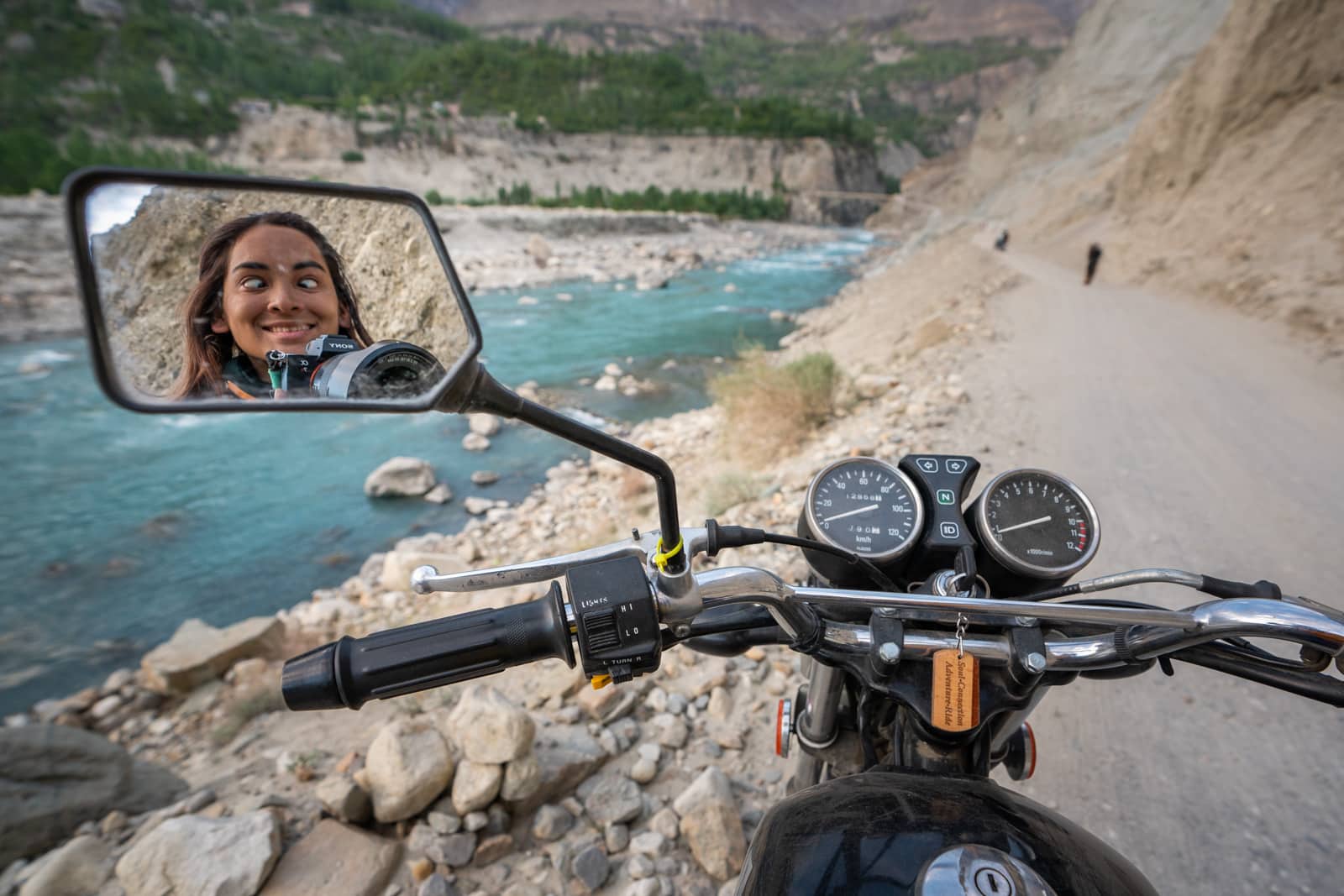
Hello, it’s me.
What’s in my camera bag?
My camera bag, of course
Lowepro Fastpack BP 250 camera bag
Sturdy, spacious enough with enough compartments for all my gear, but it doesn’t feel big when I carry it. What more do you need?
I’ve used my Lowepro camera bag for years, and it’s just the right size with enough storage for backpacking long-term.
Compartment dividers can rearrange to fit your gear. The laptop sleeve is against my back (good for preventing theft). My tripod and/or water bottle fit in a sleeve on the side. Most importantly, the camera bag has three other pockets with dividers and pouches where I can store non-photography related bits and bobs—something many camera bags lack. It even includes a built-in rain cover.
I might upgrade to a larger Lowepro backpack now that I have a drone. But I also might not because I’m pandemic!broke and can probably still mash all my gear into the Fastpack for now. We’ll see.
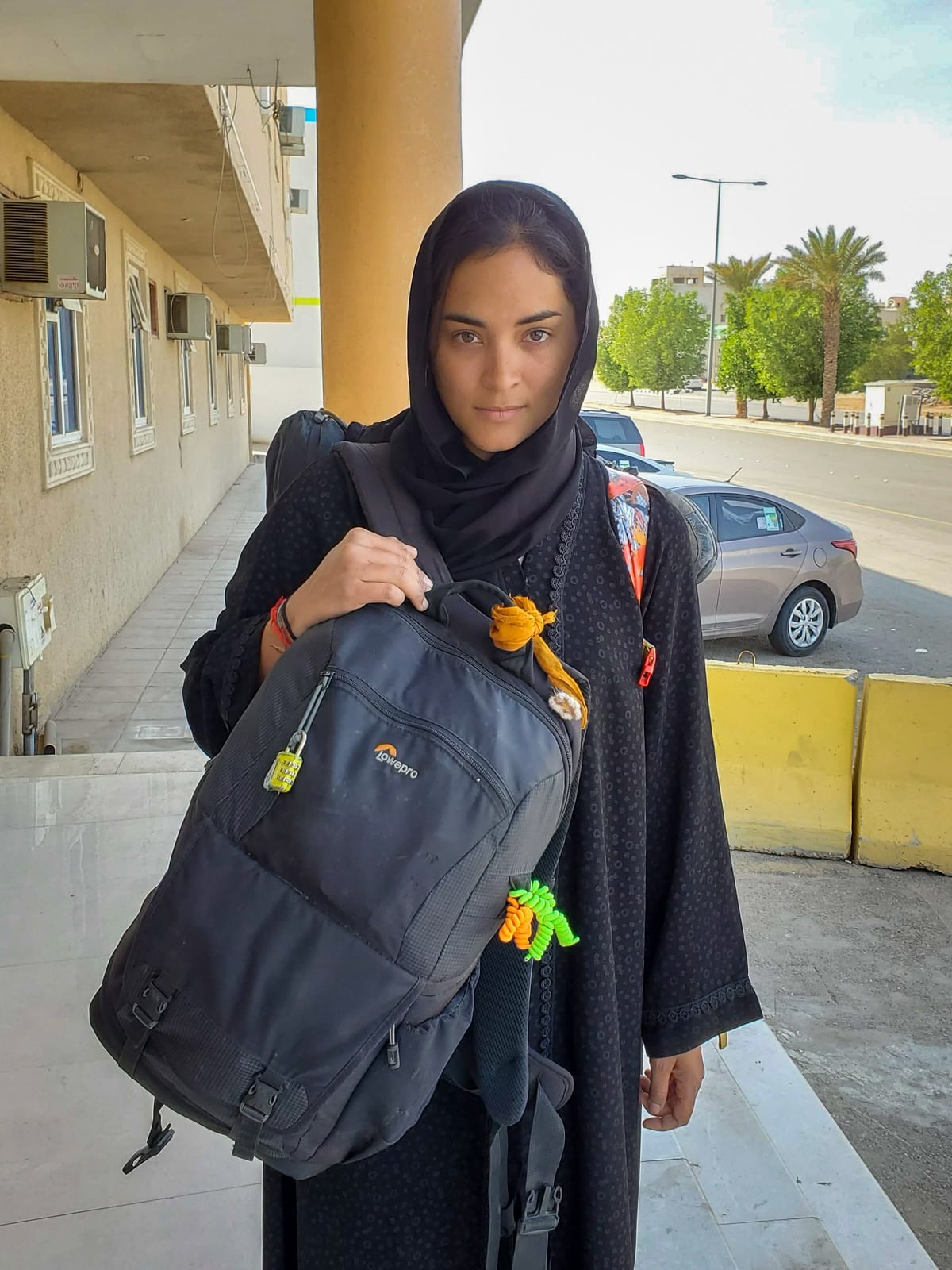
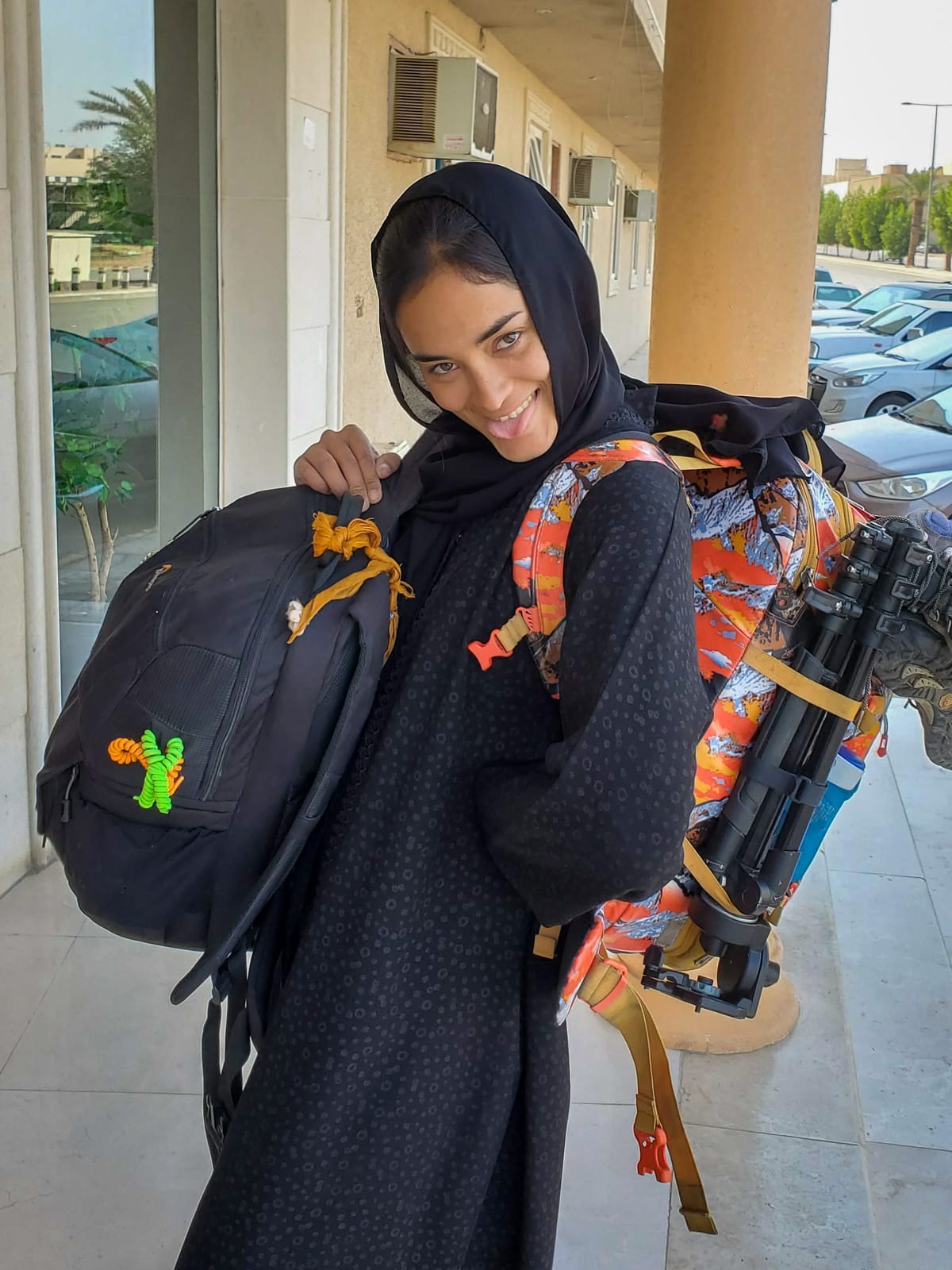
Traveler tip: Let your bag get nasty.
Though hardy, my bag looks like sh*t.
It’s dirty. Rags hang from it: one headscarf from the Golden Temple in Amritsar and one piece of an Indian bus seat cover from when the man next to me kindly tied my bag to the seat… and then couldn’t UNtie it. I often use curly neon shoelaces to secure my tripod.
It’s not professional looking at all… but that’s ideal. The crappier your stuff looks, the less likely someone is to steal it.
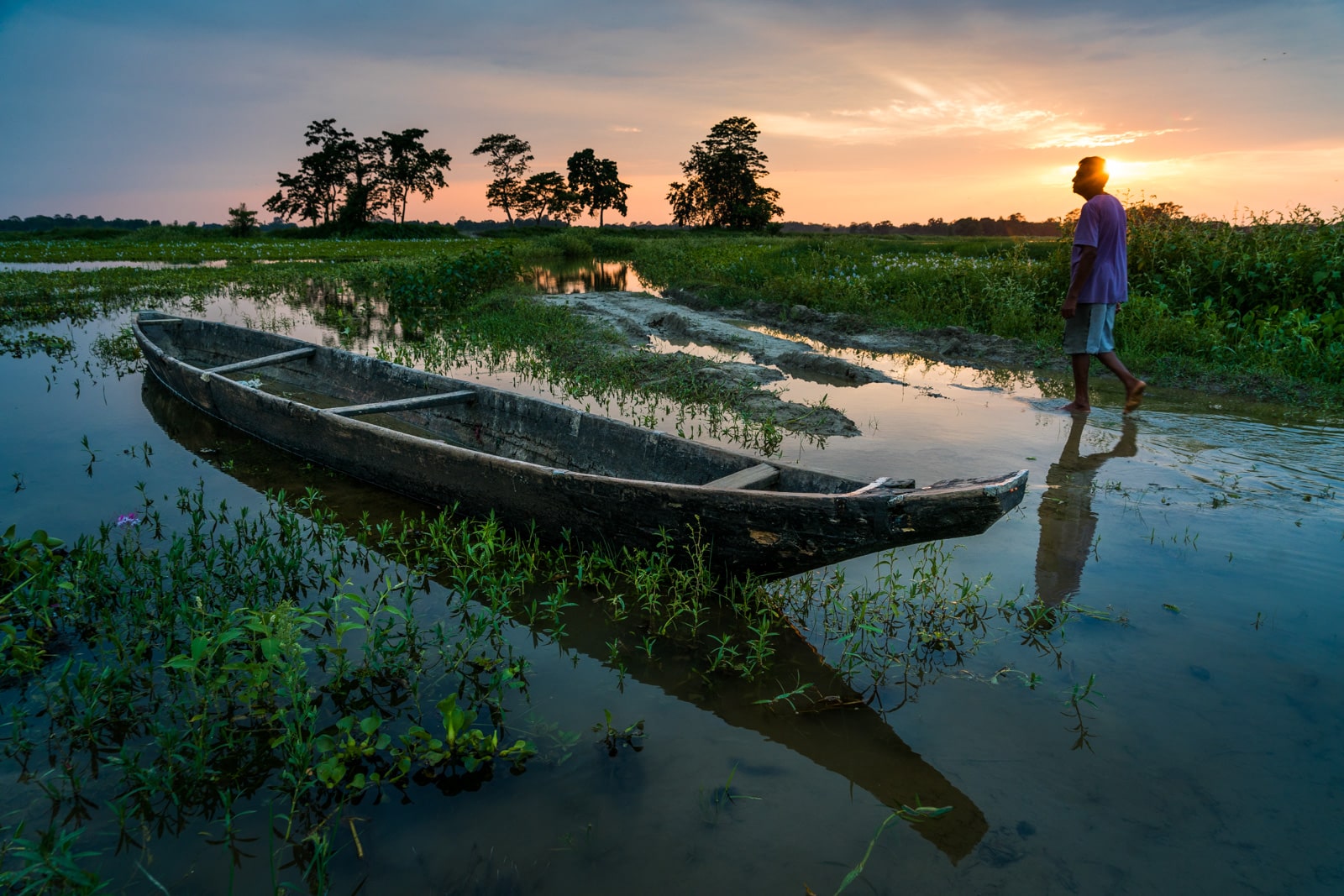
Chasing golden hour on Majuli Island, India. Info: Sony A7R2, ISO 400, 24mm, f/6.3, 1/60 sec
My babies: cameras, drone, and laptop
Backup camera: Sony A7RII
My first Sony. Similar to the successive R3, but selecting focal points is less intuitive and the battery life is painfully short.
DJI Mavic 2 Pro drone
Purchased right before the pandemic hit, so I haven’t traveled long-term with it yet. Admittedly I’m worried about drone restrictions.
GoPro Hero 7 action camera
Useful for quick or sneaky shots when you can’t pull out your camera, easy timelapses, and driving footage.
Apple Macbook Pro Retina 15″ from 2014
Expensive, but it’s held up well despite my destructive lifestyle. I think I’ll go for a 13″ laptop when it dies.
Why travel with two cameras?
Yes, I travel with a main camera and a backup. It sounds excessive—and is heavy—but I occasionally take on paid photography assignments, and I can’t afford to go without a camera in the field. The caution has already paid off: humidity killed one of my cameras while on an assignment in a remote part of the Brazilian Amazon. Good thing I had a spare, eh?
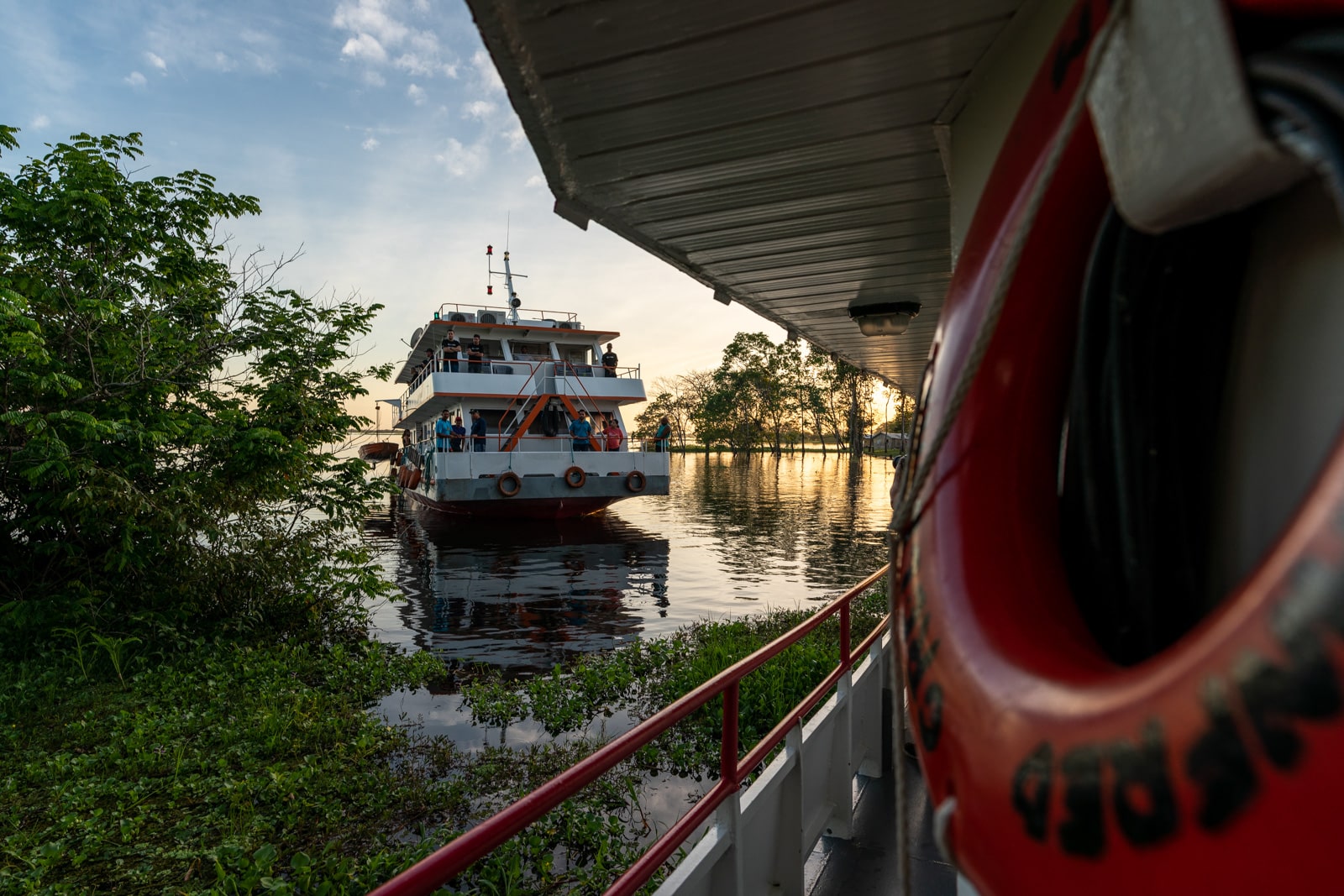
A broken camera ain’t cool when you’re photographing a clinic accessible only by boat! Info: Sony A7R3, ISO 125, 19mm, f/4.5, 1/200 sec
However, I don’t recommend traveling with a backup camera unless you’re a professional photographer/videographer. Save on weight—invest in a smartphone with a high-quality camera. I have a Samsung S20 and it takes freakin’ fabulous photos for a phone. Mobile cameras are often as good or better than point-and-shoot cameras these days!
Travel photographer tip: use what you can afford
You don’t necessarily need to travel with a full-frame camera(s) like I do. They’re not worth the money unless you can afford them or want to become more professional.
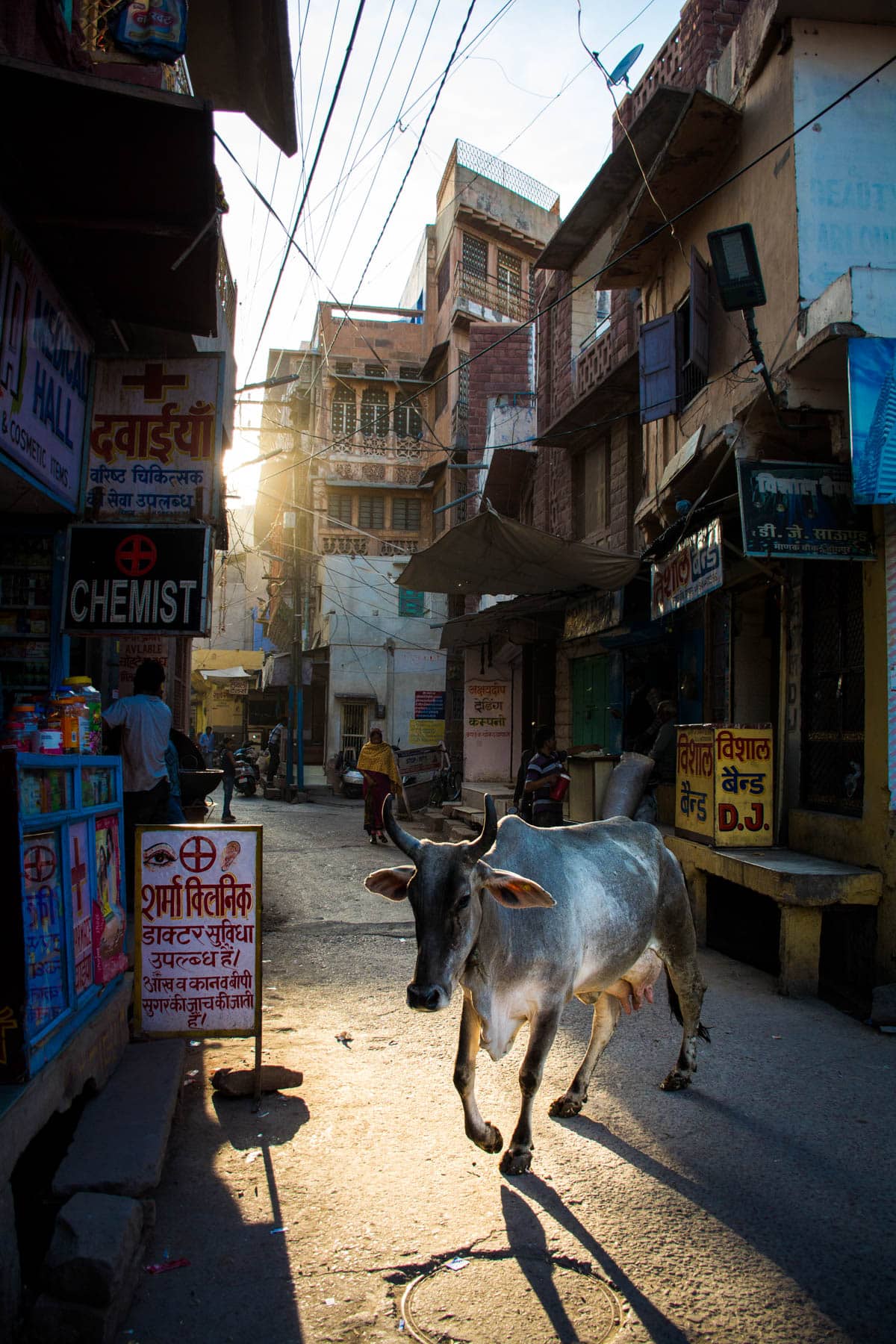
Nikon D70, ISO 400, 18mm, f/3.5, 1/1000 sec
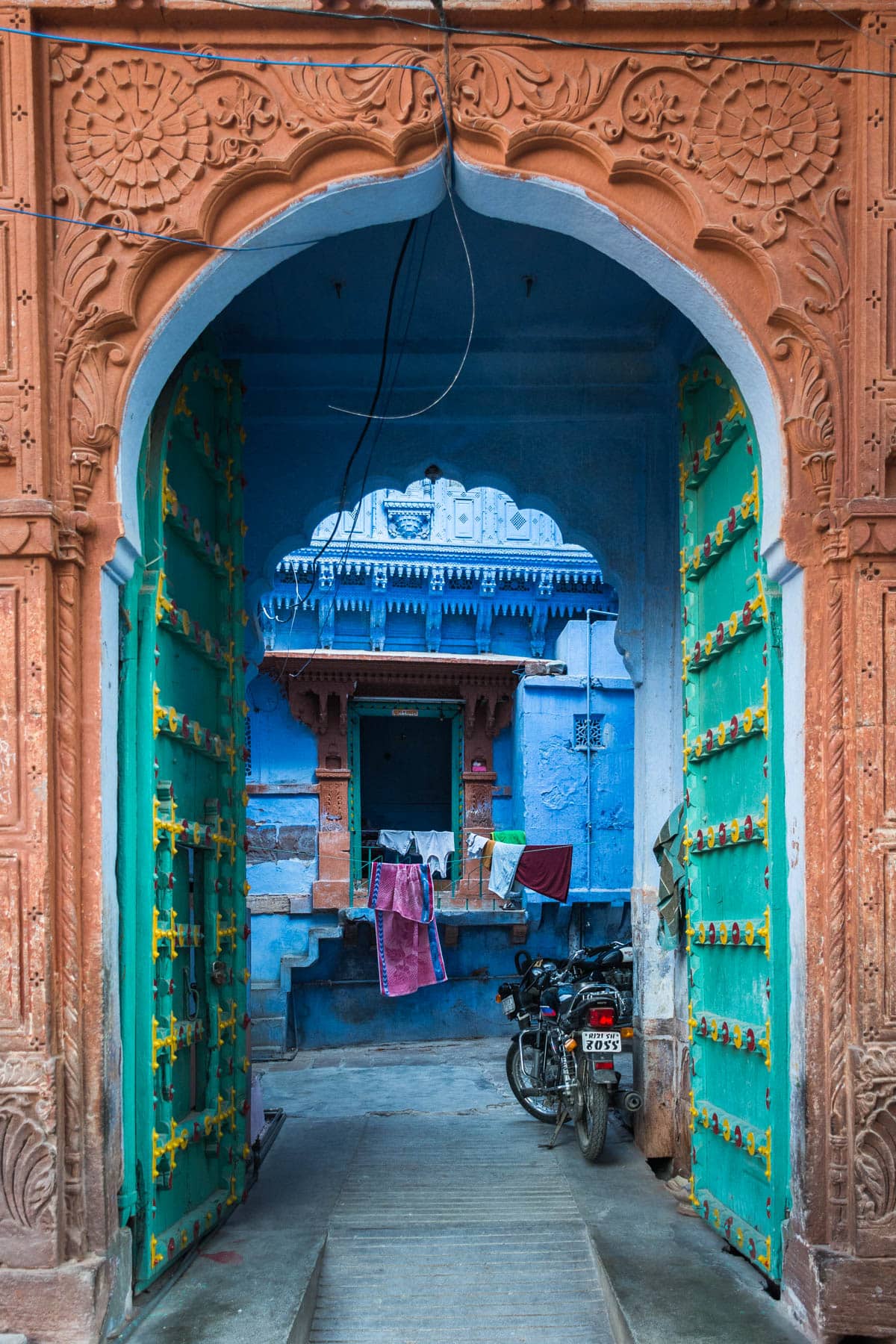
Nikon D70, ISO 400, 18mm, f/3.5, 1/250 sec
The above shots of Jodhpur, India are from a Nikon D70 camera, which I used for my first two years of travel. You don’t need crazy expensive full-frame cameras to take nice photos!
I truly believe the best camera for novice travel photographers is the one you can afford and are most likely to carry. If you want a cheaper mirrorless camera for travel, I recommend the Sony a6000 series.
Camera lenses and filters
My favorite lenses for travel photography
Wide angle: Sony FE GM 16-35mm f/2.8
Pricey, but my absolute favorite lens. I rarely take it off my camera. Its photos are so crisp, and I love how it forces me to get up close and into the action while traveling. That’s what travel is all about, right?
Telephoto-ish: Sony FE 85mm f/1.8 lens
It’s cheap, it’s light, it’s small… but the bokeh is delicious and it works for both portraits and longer shots. It’s perfect for photographers trying to cut down on weight.
Walkaround: Sony FE 28mm f/2.0
The cheap little prime lens does the job, and isn’t as conspicuous as my huge 16-35mm. I use it on casual strolls or when I want to be more subtle. People are also often less intimidated by it. However, I’d replace it with this 35mm if I had more money.
If I ever manage to make money in the pandemic my next purchase will be a broader-range lens: either a 24-70mm f/2.8 or a 28-105mm.
What filters I use
I’m no heavy filter user. (Mostly because I forget them.) However, all of my lenses have clear B+W UV filters on them for protection. I recommend all photographers do the same. You can easily replace a broken filter. A broken lens? Not so much.
I also carry a Hoya Circular Polarizer filter for shooting snowy mountains or water in harsh light.
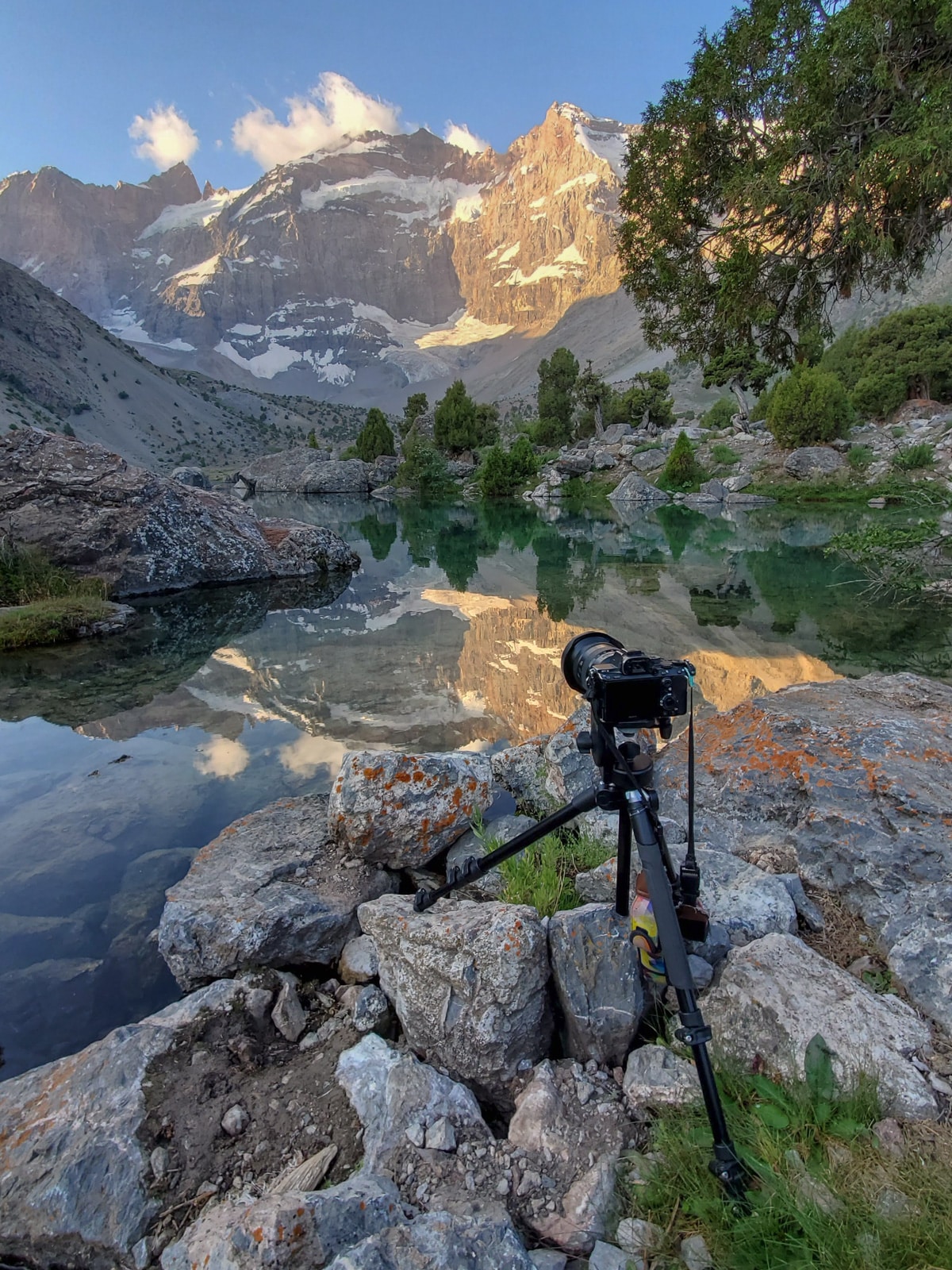
Setting up an epic portrait in Tajikistan’s Fann Mountains
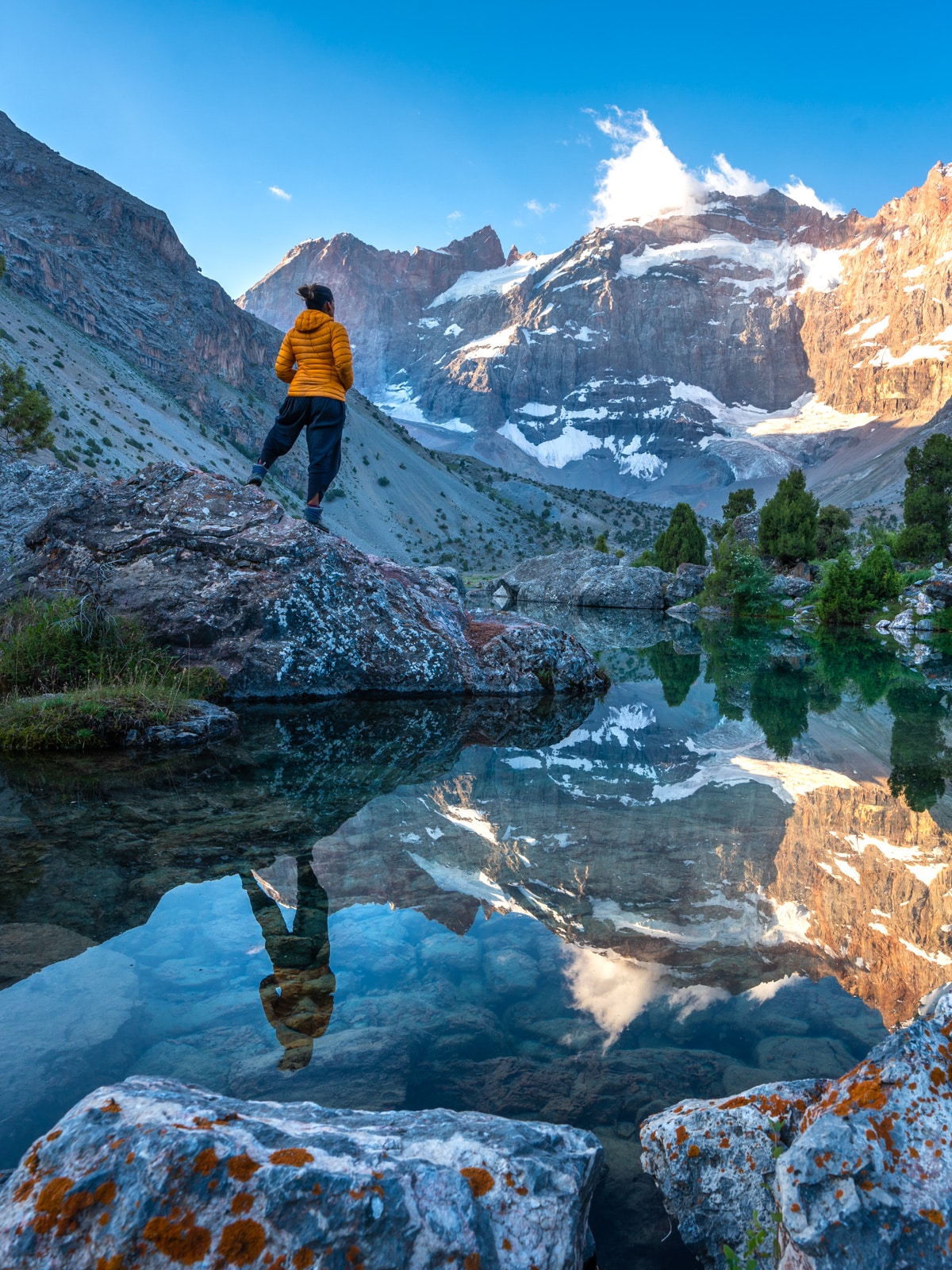
The result! Info: Sony A7R3, ISO 125, 16mm, f/10, 1/25 sec
The perfect tripod for long-term travel
You won’t die if you travel without a tripod, but they’re extremely useful for long exposure shots (ex. night photography) and taking photos of yourself if no one is around (ex. whoring yourself out on Instagram like I do).
Manfrotto Befree travel tripod
It’s the perfect travel tripod: not too heavy for a backpacker, sturdy in moderate wind, and easy to set up. Manfrotto is a reputable brand loved by many photographers, and I highly recommend this tripod to anyone in the market for one.
Note that I bought my tripod secondhand in a camera shop in Lahore, Pakistan. The tripod head you see here came from a box of abandoned heads; it isn’t the one that comes with the tripod.
I do NOT recommend the tripod head I have—it’s irritating to set up, huge, and way too heavy. In short: it sucks. I’ll replace it once my finances are less dire.
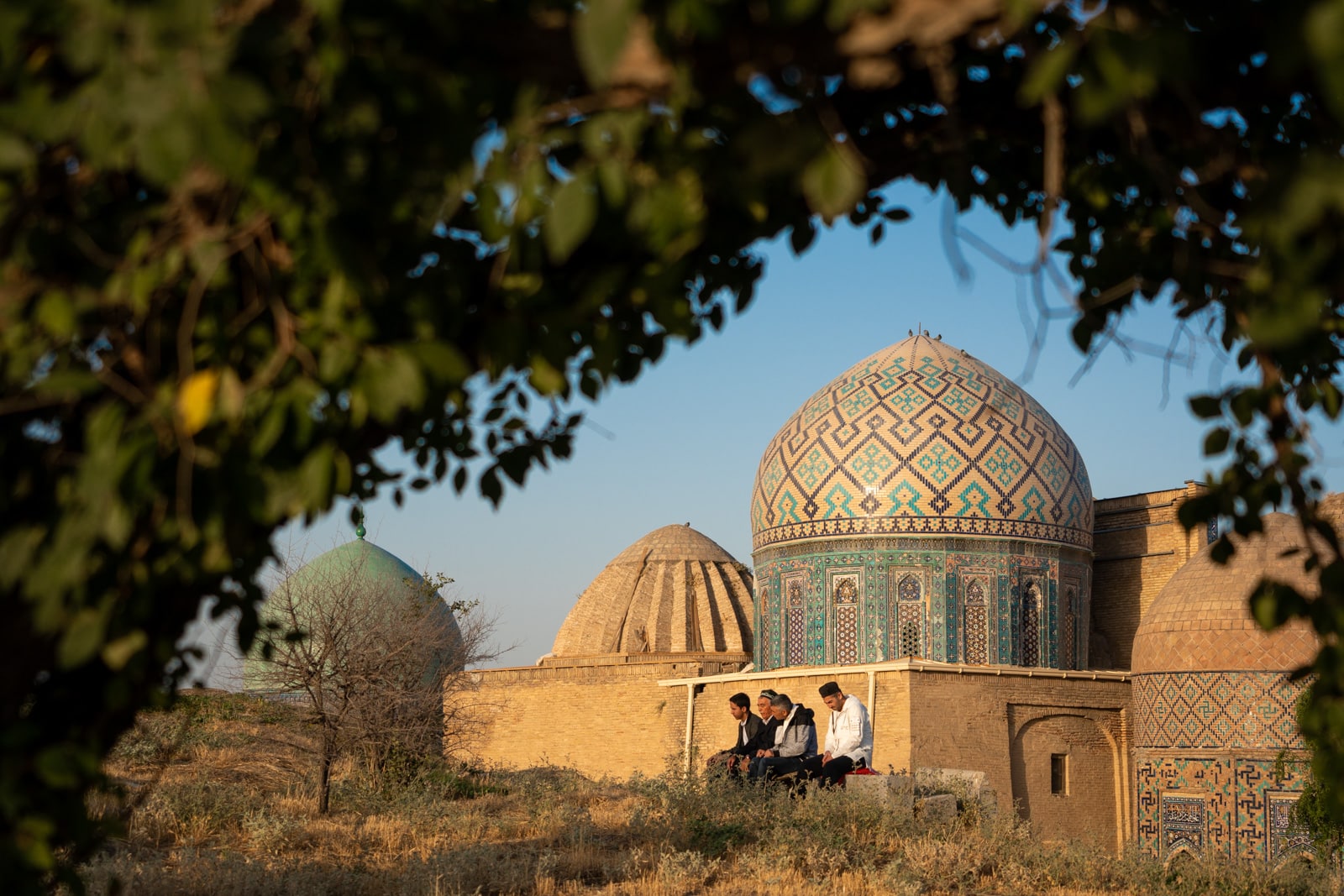
Men praying outside the Shah-i-Zinda necropolis in Samarkand, Uzbekistan. Info: Sony A7R3, ISO 250, 59mm, f/5.0, 1/1000 sec
SD cards
I almost exclusively use Sandisk Extreme Pro SD cards for my cameras, drone, and mobile. Some are SXDC (best), others SDHC (good). I have one 128GB card, several 64GB cards, and a few crappy 32GB cards as backup from older cameras.
Using primarily 64GB cards is precautionary: it forces me to clear memory cards more often. The more space on the card, the more content you’ll lose if the card fails… or you lose it. I’ve learned that the hard way multiple times.
For safety I carry my spare SD cards and microSD card readers in a waterproof SD card carrying case.
Photographer tip: don’t be cheap.
Though there are bajillions of cheap SD cards out there, don’t skimp on your SD cards. Cheaper SD cards will take longer to save photos, and you’ll find yourself missing shots because your card is too slow to take many photos at once, especially when using high-megapixel cameras.
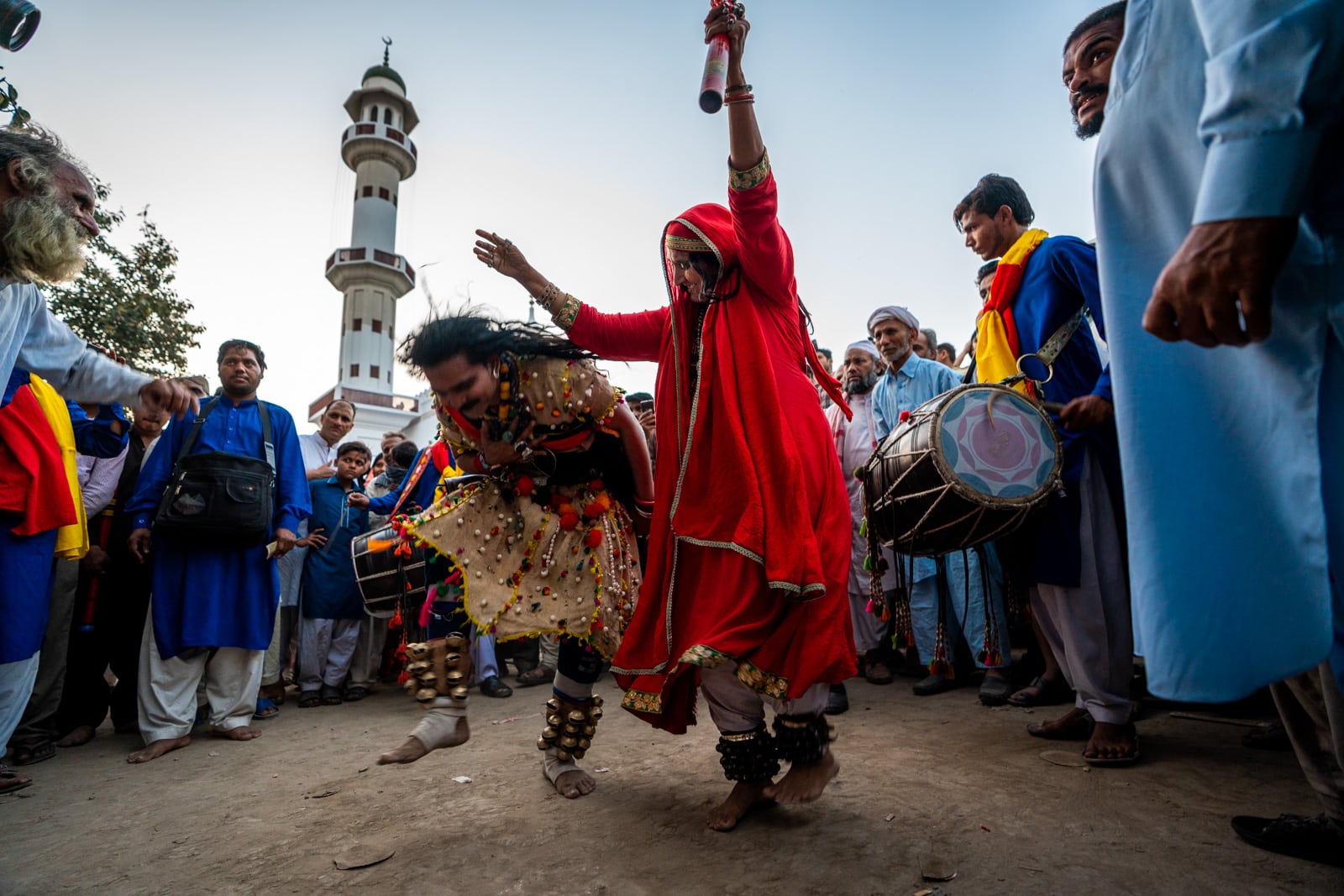
To capture all of the frenetic dancing at the Mela Chiraghan in Lahore, Pakistan, I shot at high-speed—something only possible because I have fast SD cards. Info: Sony A7R3, ISO 800, 16mm, f/2.8, 1/125 sec
External hard drives and file storage
Ah, now for the most complicated part: how to store photo and video files when traveling long-term?
I’ll get to that in a second, but for now, here are (some) of the external hard drives I carry with me on the road:
Seagate Backup Plus portable external hard drives (5TB, 4TB, 1TB)
My primary and backup storage drives for photos, videos, and other assorted digital clutter
Sandisk 500GB Extreme Portable external SSD
Smaller than the palm of my hand, it’s for running memory-intensive programs like Adobe Premiere Pro and Photoshop.
How much storage you need depends on how long you’ll be traveling, and whether or not you shoot video. I recommend always carrying two 4TB+ HDs; one for storage, and one for backup.
Traveler tip: In my experience, finding reputable hard drives while traveling through Asia has been difficult and expensive. Plan ahead, and count on only being able to find quality HDs in major cities.
File storage option for digital nomads and photographers traveling long-term
Now for the real talk: I’ve traveled with 8 HDs in my backpack before… and it, quite frankly, sucks. They heavy AF.
Traveling with HDs is a necessary evil to be treated with caution. They hold more emotional value than anything else in my camera bag. There has been literally one instance where I didn’t keep my HDs with me while traveling in the last four years: while taking a jeep in the Pamir Mountains right after nearly dying from extreme altitude sickness. And even then, I resisted (but didn’t have the energy to argue with the jeep driver).
To reduce the number of hard drives I have to travel with, I set up a new system: a Synology 1618+ NAS with 24 TB of storage (and 8 TB of backup storage) on Seagate IronWolf HDs at my parents’ home in Belgium.
How NAS systems work is a post for another day, but basically I can access it anywhere in the world. Now, I can travel with two or three external hard drives—one primary, one backup—and upload my files to the NAS whenever I have reliable WiFi.
It’s not the most elegant solution, but as a photographer shooting on the road literally every day for years, trust me: there is no elegant solution. File storage is 100,000% the most stressful part of being a digital nomad photographer.
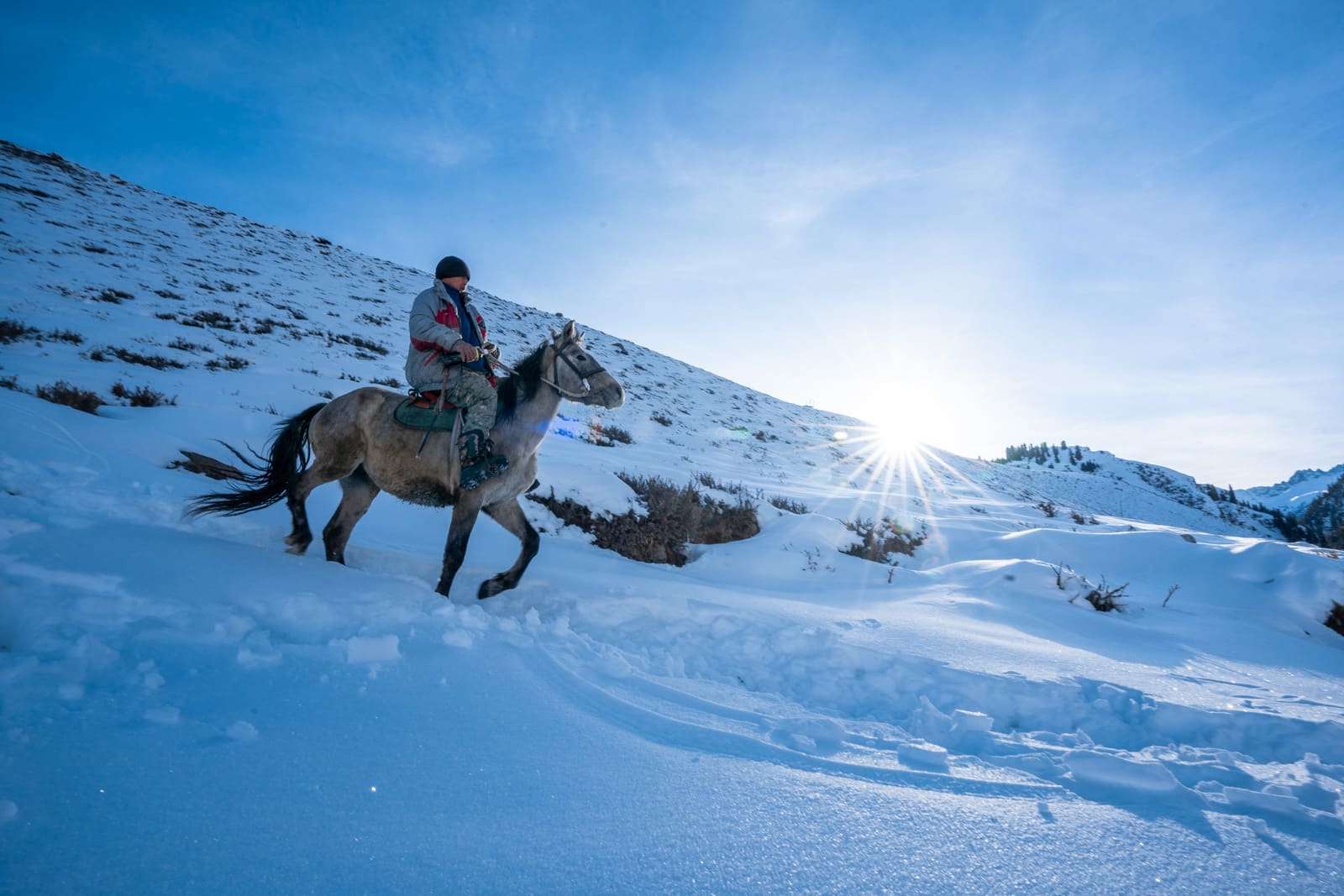
Shooting sun flares like this shot from last winter in Kyrgyzstan requires high f-stops… which means I have to clean my sensor with a rocket dust remover often or else my shots will be a nasty, dusty mess. Info: Sony A7R3, ISO 250, 16mm, f/18, 1/200 sec
My essential camera accessories
Now for all the little things you never knew you need… until you need them. Desperately.
I highly recommend all travel photographers carry these on the road; none of them are too heavy, and they’re all incredibly useful and sometimes hard to find.
Custom camera straps
There’s nothing that says “I IS PHOTOGRAPHER ROB ME PLZ” more than a camera strap with the brand splashed all over it.
Both of my cameras have colorful straps easily be mistaken for a bag strap, especially when the camera is hidden by a scarf or coat. It’s a small thing you can do to protect your gear/self that I highly recommend.
This is my favorite strap because POCKETS. I use them to carry spare batteries and SD cards; it’s truly lifesaving for forgetful messes like me.
Multiple spare batteries
Always have at least one spare battery per camera, ideally more. You can charge one while using the other, especially important when camping or traveling in places where electricity is not a given.
Replacement lens caps
As a serial loser of lens caps, THESE ARE SO IMPORTANT ON THE ROAD. I’ve dropped lens caps off mountains in Pakistan, lost them in deep snow in Kyrgyzstan, and drunkenly forgot them in hostels in Georgia.
After making a fool of myself traveling around with lenses protected by plastic bags held on with hair ties, I learned some lessons. I purchased 3-packs of replacement lens caps for each of my lenses (and already lost all 3 for my wide-angle lens).
Small rocket blower dust remover
This is clutch for keeping your camera sensor clean on the road, especially in dusty locales. Most rocket blowers are too big for my liking, but this small version fits easily into empty niches of my camera bag, and I try (and fail) to use it to clean my camera sensor daily. It does the job.
A million lens cloths
They weigh nothing, you’re going to use AND lose them, and if I had a dollar for every time I saw a photographer with a freakin’ nasty scummy lens, I would have enough money to buy a new camera by now.
Waterproof bags
I always, always make sure to have some kind of waterproof bag with me when wandering with camera. Rain can be intense—especially in countries with monsoons—but if it begins to pour I can simply pop my camera into the bag and carry on. I carry a few dry bags for this purpose, but I’ve also used everything from plastic wrappers to plastic shopping bags. Looks be damned—use what you have on me.
Travel adaptors with multiple USB ports
Essential for me because I’m an international mess with devices from freakin’ everywhere, but also super useful for charging multiple batters and devices at once.
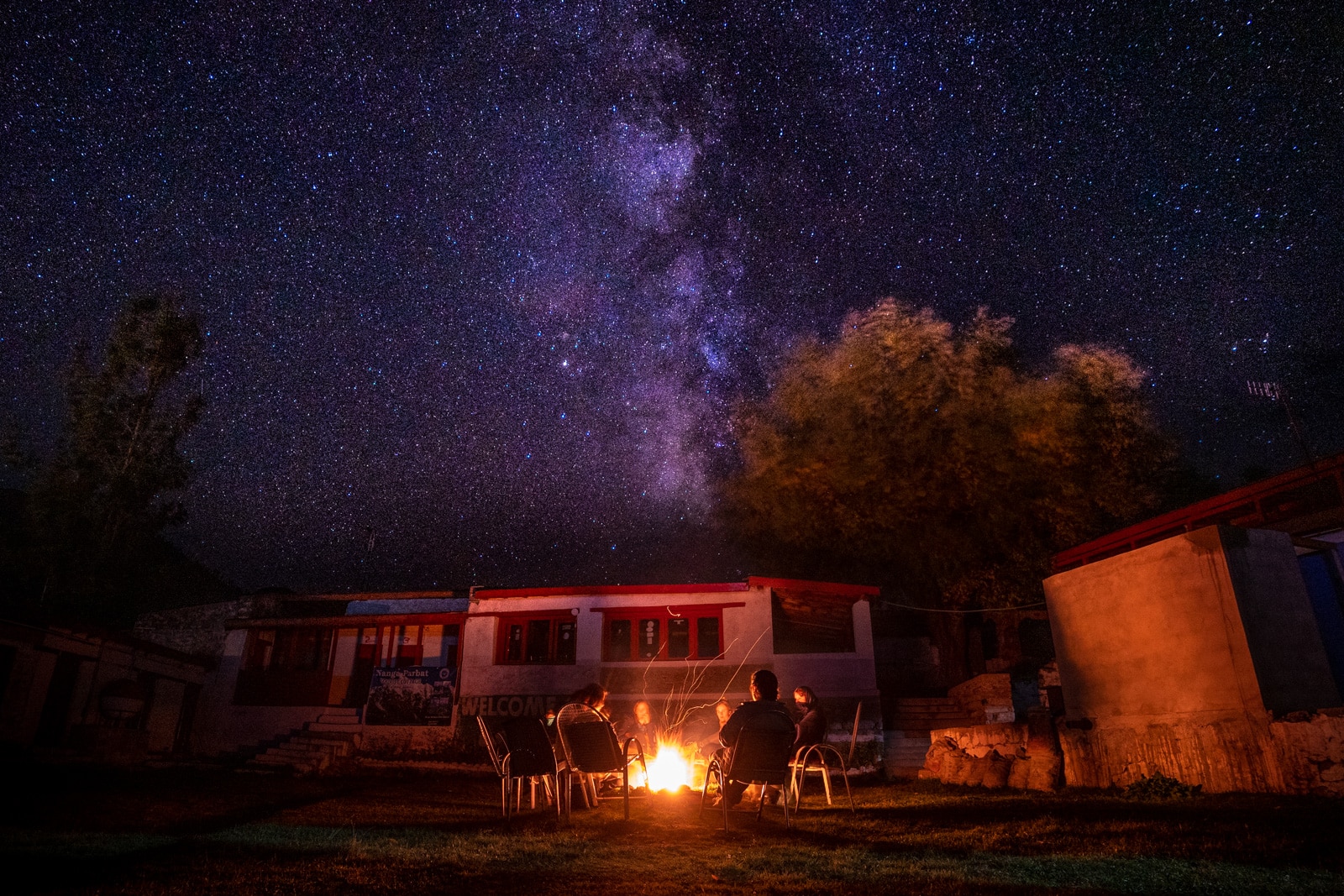
Campfire chilling on our first women-only tour of Pakistan—a scene I wouldn’t be able to capture sans-tripod. Info: Sony A7R3, ISO 2500, 16mm, f/4.0, 8 sec
Other useful photography accessories
Not as essential as the other items mentioned, but the fact that I carry them anyway is a sign of how important they are to me. If they’re useful for you, these are worth the extra weight:
- Power bank: One of my most beloved items that I recommend to travelers. Durable, can charge phones several times over, AND I’ve used it to charge my cameras—yes, including my Sony. I use and recommend my Anker PowerCore 20000 power bank.
- Universal power strip + surge protector: I often stay in budget accommodation where rooms only have one outlet (which sometimes doesn’t work). Not cool when you have to charge your phone, camera batteries, AND laptop. The power strip I currently use is a very dubious quality strip from a bazaar in Pakistan—replaced after the melty death of another Very Dubious Quality strip—but I’m replacing it with this awesomely compact travel power strip/surge protector.
- Electrical or duct tape: I’ve used tape to secure camera straps, hold battery compartments shut, waterproof cracks in lenses… and those are just the photography fixes! EVERY traveler, photographer or not, should travel with tape.
- Extra hard drive cables: Hard drive cables have died on me in the past, and I assure you finding replacement cables is NOT easy, especially when you’re asking around in a foreign language in the middle of who knows where. “USB 3.0 External drive cable” isn’t an easy phrase to mime, just sayin’.
- Packing cube or pouch for cables: Cables are the Chekhov’s gun of camera bags: if there are cables, they will tangle. A traveler trick I learned is to carry cables in a dedicated bag to save headache and packing stress. They’ll still get tangled, but only with each other.
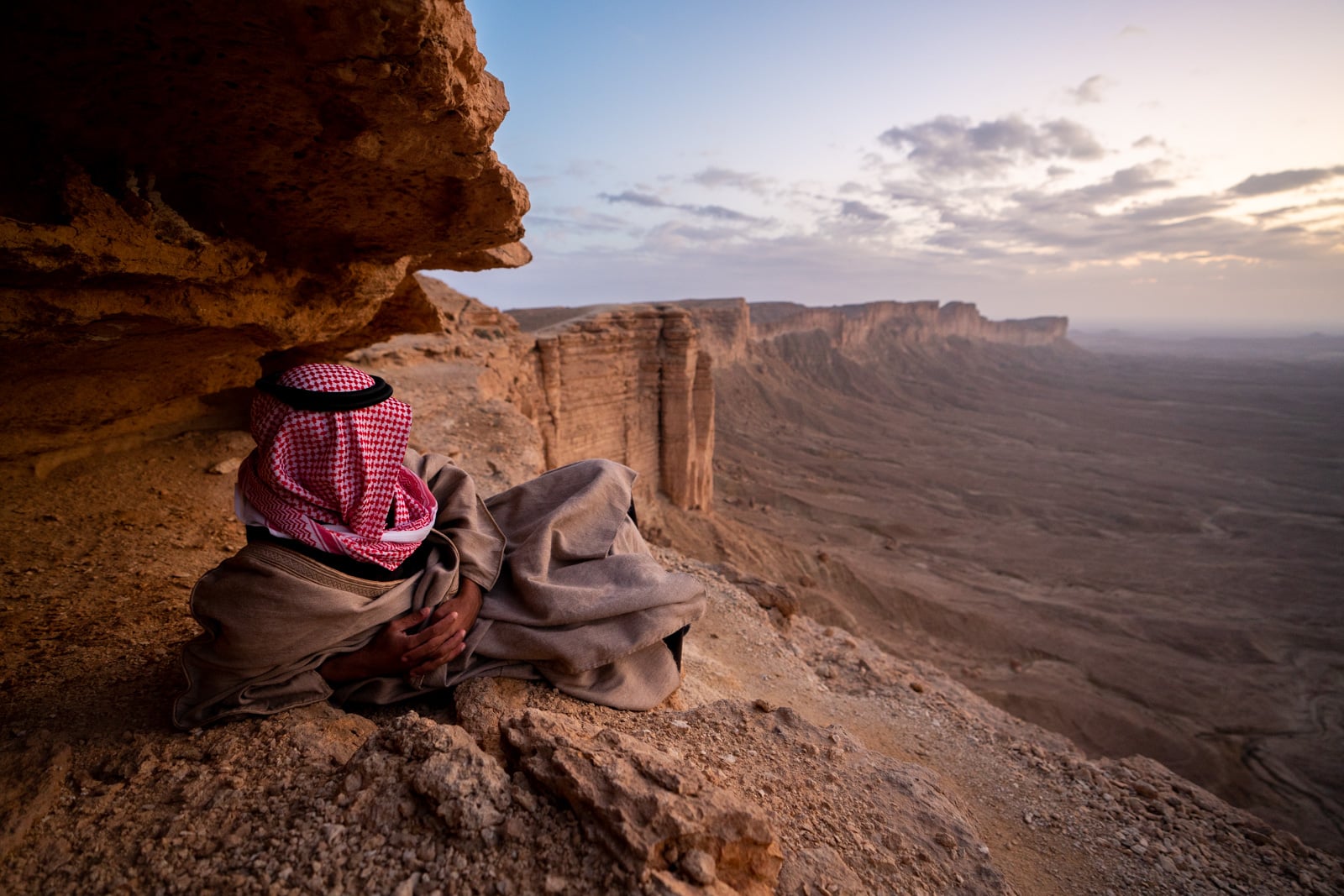
Savoring blue hour at the Edge of the World in Saudi Arabia. Info: Sony A7R3, ISO 800, 17mm, f/2.8, 1/40 sec
What I camera gear I DON’T carry and why
There are some items I purposefully don’t travel with:
Long telephoto lenses (more than 200mm): SO HEAVY. Seriously – telephotos are insanely heavy and wildly impractical for carrying long-term unless you are ABSOLUTELY POSITIVE you will regularly do wildlife photography. Otherwise, I recommend renting a lens in the nearest major city whenever you want to do wildlife photography or anything else of telescopic lengths.
Camera remote: People swear by them and they make taking photos of yourself easier, but I just use mobile apps to control my Sony cameras and GoPro. Less comprehensive, but one less item to pack.
Intervalometer: Useful for time lapses, but the latest Sony cameras have built-in intervalometers that suffice for the average amateur travel photographer.
Flashes: They’re big, ungainly, and I prefer natural light. Besides, there’s no way you can use a flash while traveling without looking like an obnoxious twit; save your back and leave the flashes in the studio.
Selfie stick: I used to carry one, but never used it. To be fair, they’re not heavy and they’re useful for filming action-oriented activities.
Gimbal: Expensive, but worth it if you’re interested in vlogging or travel videos (which I wasn’t until recently). I’ve only made a few vlogs so far, but I might invest in a gimbal if I make more in the future.
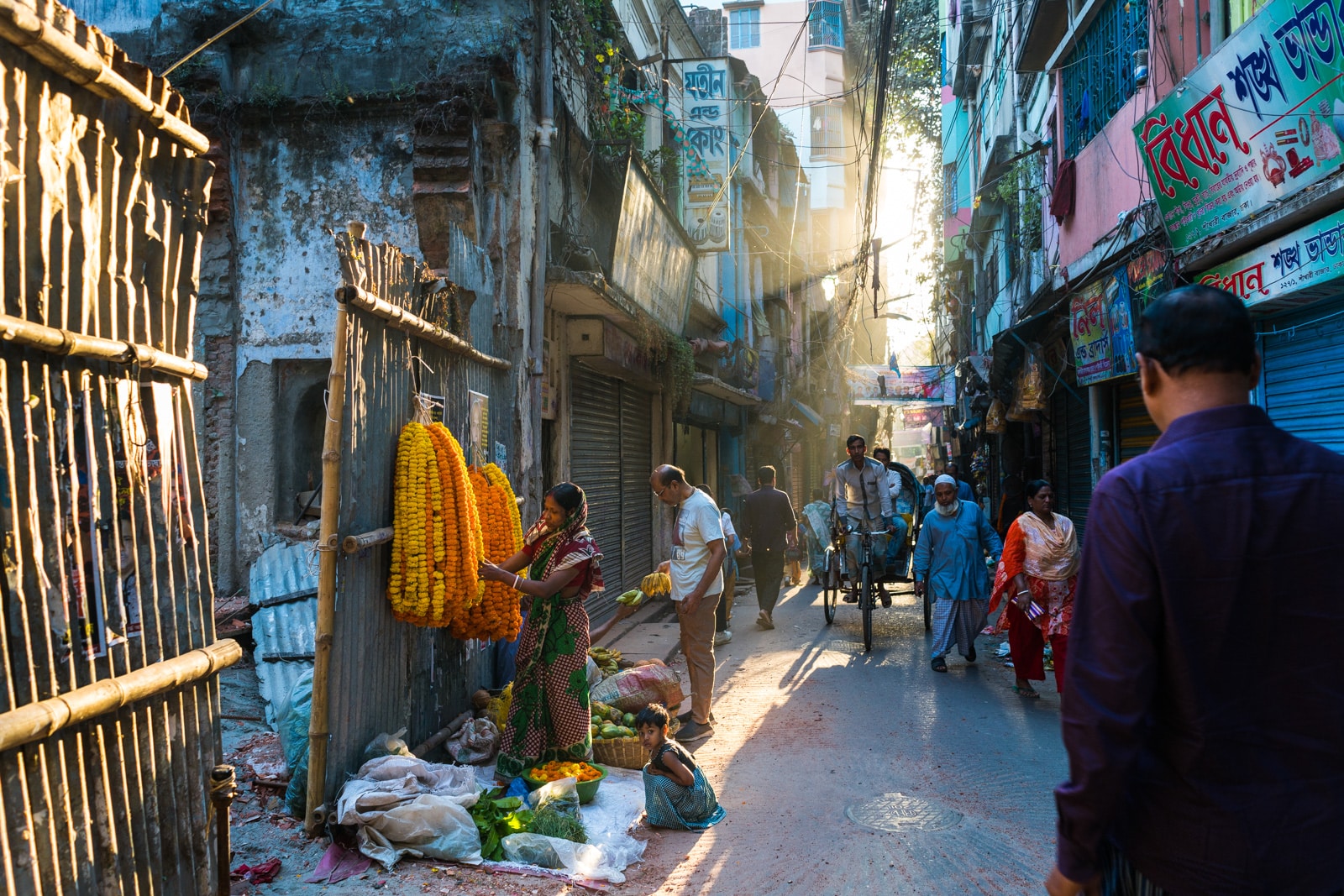
Early mornings on the streets of Dhaka, Bangladesh. Info: Sony A7R2, ISO 400, 28mm, f/4.0, 1/160 sec
How heavy is my camera bag?
Fun fact: my camera bag weighs more than my main backpack.
When everything is packed—including random tidbits like pens, a journal, and my hoarded stash of tea bags—my camera bag usually weighs 18 kilograms (40 lbs.) or more.
It sounds extreme, but it’s not much compared to what I’ve seen other photographers travel with. I won’t lie, it’s pretty sh*t to carry, but that’s what you gotta do when photography is part of your job… and you don’t have a home.
I’m not telling this to deter you, but rather prepare you for the (very heavy) reality of what it’s like to travel long-term with photography gear. Brace yourself… literally.
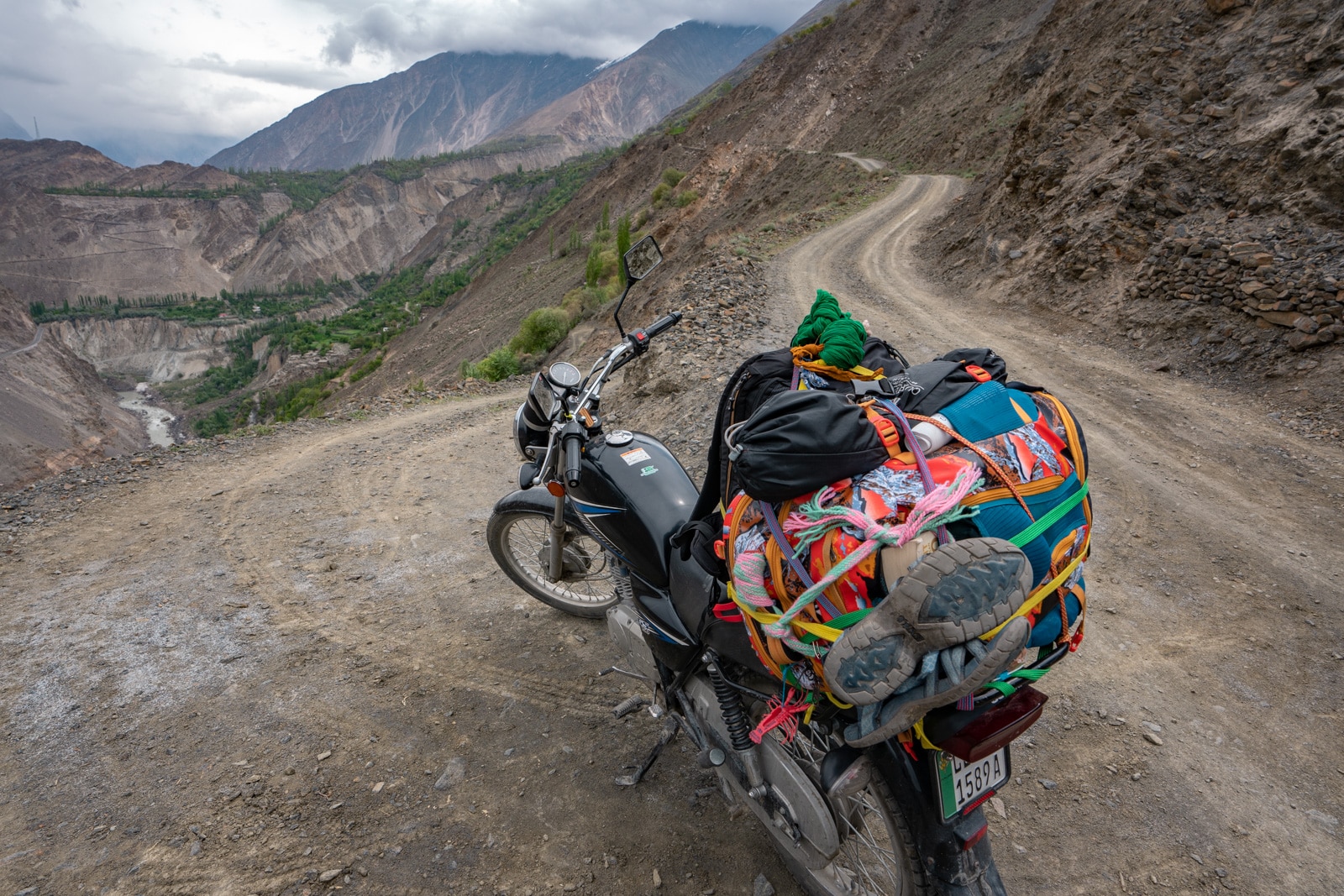
Things my camera bag has survived: repeatedly smashing into the ground while I learned to motorbike in the mountains of Pakistan.
Tips for traveling with a (heavy AF) camera bag
All the things I do to protect my photography gear is a post for another day, but here are 3 simple tips for traveling with camera gear.
1. Never EVER check your camera bag when flying.
Airport theft is real, and your camera bag is the LAST bag you want to lose in the bowels of airport luggage networks.
Do your best to play off its weight at check in—or, ideally, self check-in or leave the bag with a friend—and if an airline attendant points it out, don’t give in immediately. In my experience, many attendants are flexible. If not, be firm and point out that lithium batteries are not allowed in checked luggage, and your camera bag is full of them. That’s saved me multiple times.
2. Keep your camera bag with you at all times in transport.
Same goes for other travel with your bag. Never let anyone tie it on top of a bus or a car or a rickshaw or ??? Keep it in your lap when hitchhiking or riding in taxis, not in the trunk. Your ride might be uncomfortable, but that’s better than having to pay to replace your gear.
3. Use your camera bag’s waist straps.
Dorky as they may look, they’re important: your hips can safely bear more weight than your shoulders. Camera bags with hip straps will help to relieve your shoulders and prevent back pain.
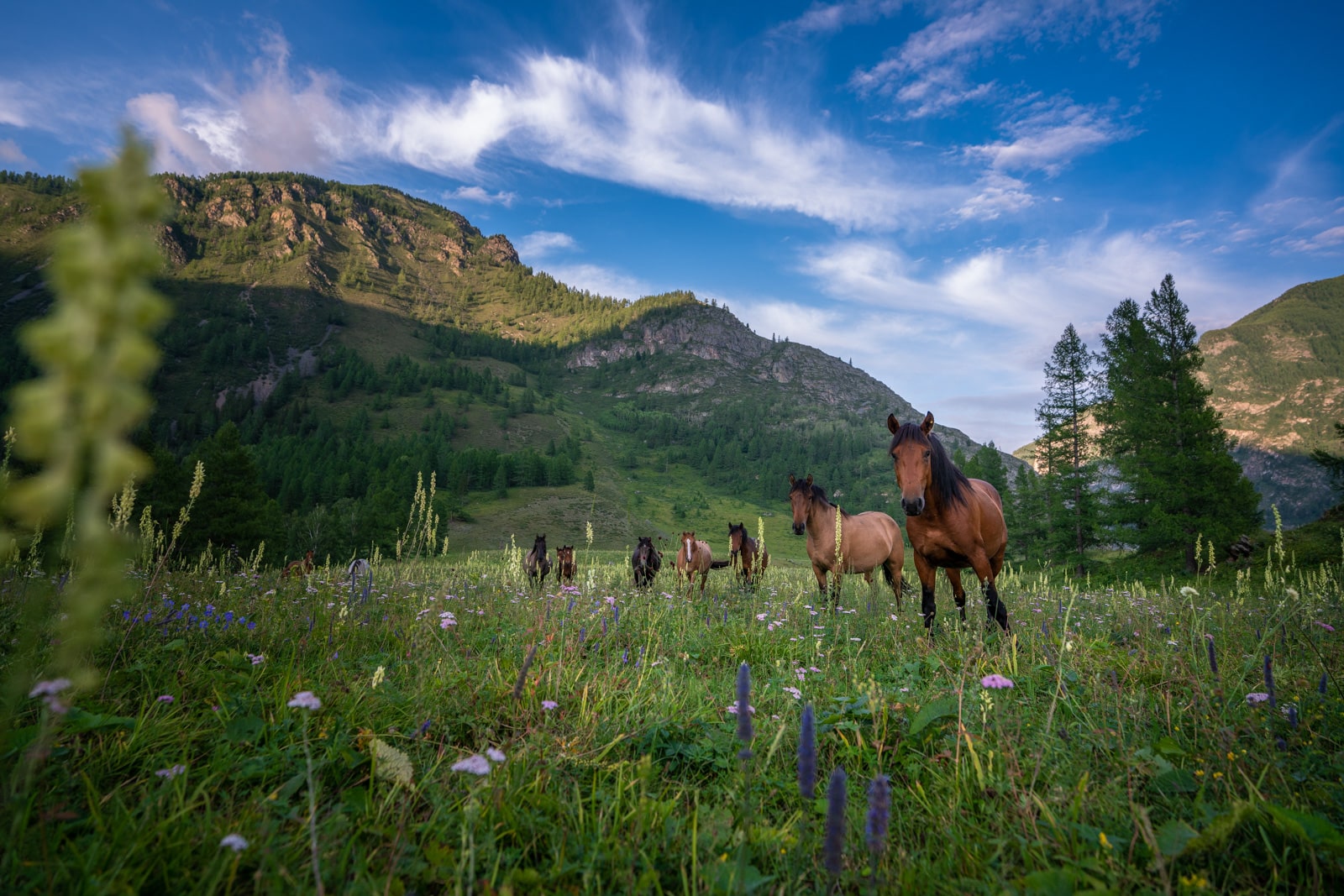
Horsing around in the Altai Republic of Russia. Info: Sony A7R3, ISO 400, 18mm, f/3.5, 1/800 sec
More about cameras and travel photography
Hopefully you’ve learned something about packing camera gear for long-term travel. If not, well, congratulations for reading this far. I salute your attention span.
For more advice about cameras and travel photography, check out some of my other posts:
- Essential advice for beginner travel photographers
- Choosing the best travel camera: how I upgraded to a Sony A7R2
Otherwise, happy shooting and safe travels.
What gear do you always pack when traveling? Tell me in the comments!
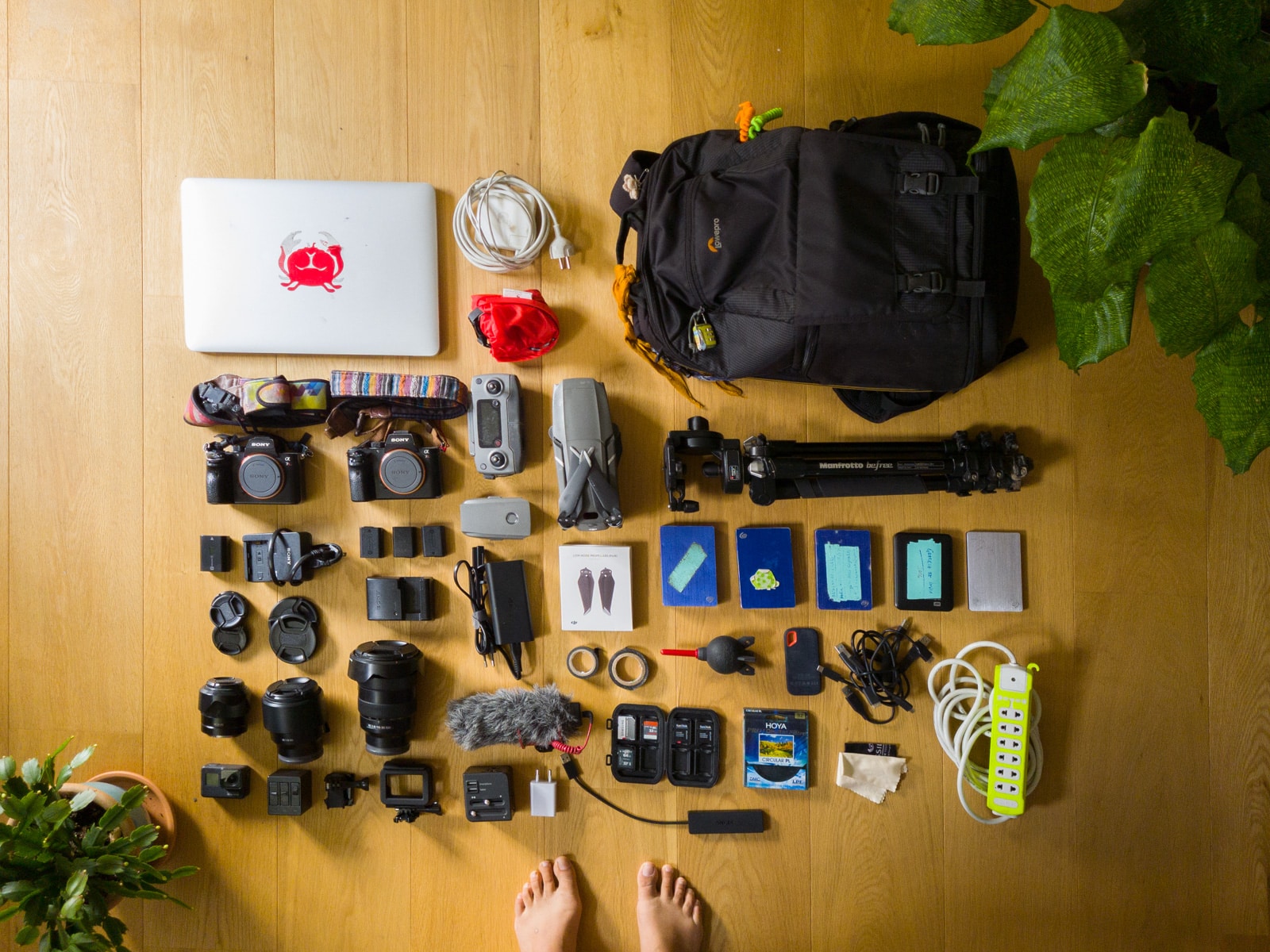
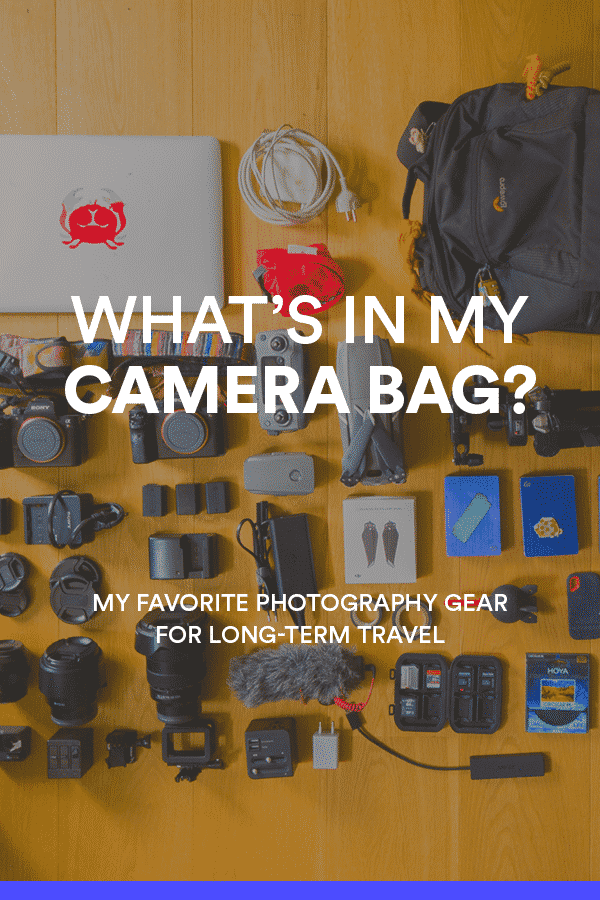
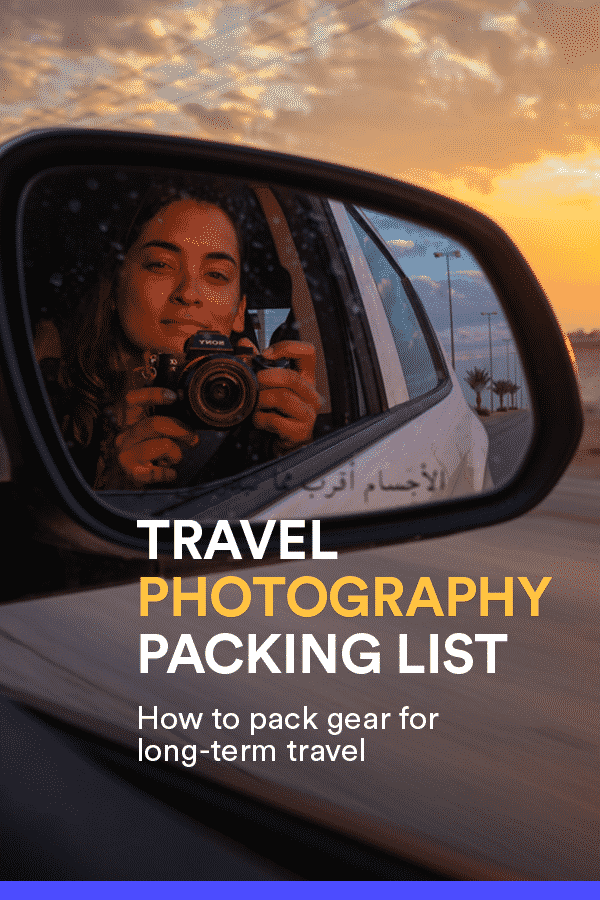




















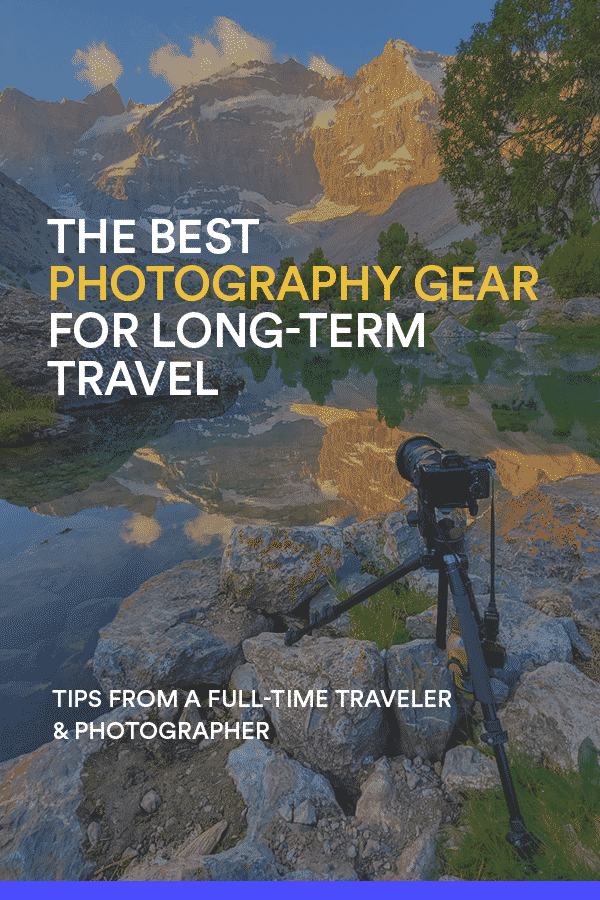
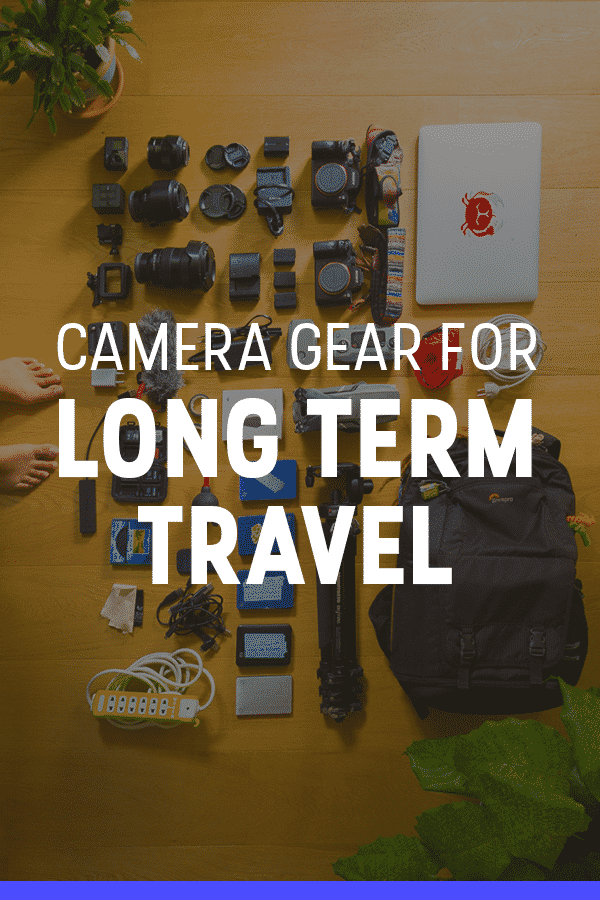


Wow, excellent info! Carrying all that weight…yikes.
On the bright side, I now have legs of steel 😉
Hey Alex – this actually makes me feel 10 times better. I am a banker and a leisure photographer and blogger, but I somehow feel ridiculous guilt at dragging quite this much of gear around. Keep going!
Wow nice article. Thank you for sharing this article with everyone.
Hey Alex, nice post! I am deciding between the sony a7r ii and the sony a7 iii. I like the 42mp but it also scares me in the way that I don’t know if my pc can handle it in lightroom.. Do you have trouble editing the huge files? I only have 6gb ram and intel core i3.. The lenses that I’m looking at are the 16-35 f/4 and 24-105 f/4. I see that you have the 16-35 gm and are looking to buy the 24-105 f/4. I was wondering if you ended up buying the lens? I’m mainly going to be shooting landscape photography this year. I really love the wide-angle of the 16mm but also would like to make the background bigger by zooming… So I’m having a hard time choosing the lens and camera. I hope you can give me some advice.